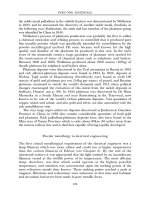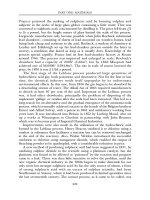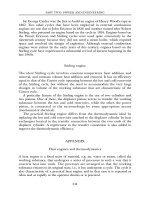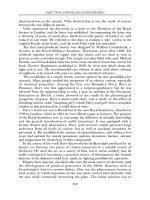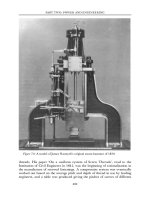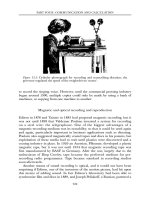Encyclopedia of Finance Part 16 potx
Bạn đang xem bản rút gọn của tài liệu. Xem và tải ngay bản đầy đủ của tài liệu tại đây (365.49 KB, 11 trang )
Chapter 29
MARKET EFFICIENCY HYPOTHESIS
MELODY LO, University of Southern Mississippi, USA
Abstract
Market efficiency is one of the most fundamental
research topics in both economics and finance. Since
Fama (1970) formally introduced the concept of
market efficiency, studies have been developed at
length to examine issues regarding the efficiency of
various financial markets. In this chapter, we review
elements, which are at the heart of market efficiency
literature: the statistical efficiency market models,
joint hypothesis testing problem, and three categor-
ies of testing literature.
Keywords: market efficiency; security returns; in-
formation; autocorrelation; serial correlation
(tests); random walk model; (sub)martingale; hy-
pothesis testing; (speculative) profits; trading rules;
price formation
29.1. Definition
The simplest but economically reasonable state-
ment of market efficiency hypothesis is that
security prices at any time fully reflect all avail-
able information to the level in which the profits
made based on the information do not exceed
the cost of acting on such information. The cost
includes the price of acquiring the information
and transaction fees. When the price formation in
equity market satisfies the statement, market
participants cannot earn unusual profits based
on the available information. This classical
market efficiency definition was formally intro-
duced by Fama (1970), and developed at length
by researchers in the field.
29.2. The Efficient Market Model
Much of work on this line of research is based on
an assumption that the condition of market equi-
librium can be stated in terms of expected returns.
Although there exists diversified expected return
theories, they can in general be expressed as fol-
lows:
E(
^
pp
i,tþ1
) ¼ [1 þ E(
^
rr
i,tþ1
jI
t
)] Â p
i,t,
(29:1)
where E is the expected value operator; p
i,t
is the
price of security i in period t, r
i,tþ1
is the one-
period rate of return on security i in the period
ending at t þ 1, and E(r
i,tþ1
jI
t
) is the expected
rate of return conditional on information (I ) avail-
able in period t. Also, variables with hats indicate
that they are random variables in period t. The
market is said to be efficient, if the actual security
prices are identical to their equilibrium expected
values expressed in Equation (29.1). In other
words, if the actual security price formation fol-
lows the market efficiency hypothesis, there would
be no expected returns=profits in excess of equilib-
rium expected returns. For a single security, this
concept can be expressed as follows:
E(
^
ZZ
i,tþ1
jI
t
) ¼ 0, and
Z
i,tþ1
¼ r
i,tþ1
À E(
^
rr
i,tþ1
jI
t
),
(29:2)
where Z
i,tþ1
is the return at t þ 1inexcessof
the equilibrium expected returns anticip a ted at t.
This concept can also apply to the entire security
market. Suppose that market participants use infor-
mation, I
t
, to allocate the amount, l
i
(I
t
), of fund s
available to each of n security that makes up the entire
security market. If the price formation of each of n
security f ollows Equa tion (29.2), then t he total excess
market value at t þ 1(
^
VV
tþ1
) equals to zero, i.e.
E(
^
VV
tþ1
jI
t
) ¼
X
n
i¼1
l
i
(I
t
)E(
^
ZZ
i,tþ1
jI
t
) ¼ 0: (29:3)
The general efficient market models of Equations
(29.2) and (29.3) are the foundations for empirical
work in this area. Researchers in the field largely
agree that security prices ‘‘fully reflect’’ all available
information has a direct implication: successive
returns (or price changes) are independent. Conse-
quently, researchers tend to conclude market is
efficient if there are evidences that demonstrate
E(
^
ZZ
i,tþ1
jI
t
) ¼ 0andZ
i,t
is uncorrelated with Z
i,tþk
for any value of k. S imilarly, if E(
^
VV
tþ1
jI
t
) ¼ 0and
V
i,t
is uncorrelated w ith V
i,tþk
for any value of k,
market is evident to be efficient.
Based on efficiency models in Equations (29.2)
and (29.3), two special statistical models, submar-
tingale and random walk, are closely related to the
efficiency empirical literature. The market is said
to follow a submartingale when the following con-
dition holds:
E(
^
ZZ
i,tþ1
jI
t
) $ 0 for all t and I
t
: (29:4)
The expected returns c onditional on I
t
is nonnegative
and has an important implication on trading rule.
This means investors should hold the security once it
is bou ght during any future period, because selling it
short cannot generate larger returns. More import-
antly, if Equation (29.4) holds as equality, the market
is said to follow a martingale. Researchers usually
conclude that security prices follow ‘‘patterns’’ and
market is inefficient when the empirical e vidences are
toward rejection of a martingale model.
The security prices exhibit the random walk
statistical property if not only that the successive
returns are independent but also that they are
identically distributed. Using f to denote the dens-
ity function, the random walk model can be ex-
pressed as follows:
f (r
i,tþ1
jI
t
) ¼ f (r
i,tþ1
) for all t and I
t
: (29:5)
The random walk property indicates that the return
distributions would repeat themselves. Evidences
on random walk property are often considered to
be a stronger supportive of market efficiency hy-
pothesis than those on (sub)martingale property.
29.3. The Joint Hypothesis Problem
The continuing obstacle in this line of empirical
literature is that the market efficiency hypothesis
per se is not testable. This is because one cannot
test market efficiency hypothesis without imposing
restrictions on the behavior of expected security
returns. For example, the efficiency models of
Equations (29.2) and (29.3) are derived based on
a joint hypothesis: (i) the market equilibrium re-
turns (or prices) are assumed to be some functions
of the information set and (ii) the available infor-
mation is assumed to be fully utilized by the mar-
ket participants to form equilibrium returns, and
thereby current security prices. As all empirical
tests of market efficiency are tests of a joint hy-
pothesis, a rejection of the hypothesis would al-
ways lead to two possible inferences: either (i) the
assumed market equilibrium model has little abil-
ity to capture the security price movements or (ii)
the market participants use available information
inefficiently. Because the possibility that a bad
equilibrium model is assumed to serve as the
benchmark can never be ruled out, the precise
inferences about the degree of market efficiency
remains impossible to identify.
29.4. Three Categories of Testing Literature
The empirical work on market efficiency hypoth-
esis can be categorized into three groups. First,
weak-form tests are concerned with how well past
586 ENCYCLOPEDIA OF FINANCE
security returns (and other explanatory variables)
predict future returns. Second, semi-strong-form
tests focus on the issue of how fast security price
responds to publicly available information. Third,
strong-form tests examine whether security prices
fully reflect private information.
29.4.1. Weak-Form Tests
Controversy about market efficiency centers on the
weak-form tests. Many results from earlier works
on weak-form tests come directly from the submar-
tingale expected return model or the random walk
literature. In addition, much of the earlier works
consider information set as just past historic re-
turns (or prices). The most frequently used proced-
ure to test the weak form of efficient markets is to
examine whether there is statistically significant
autocorrelation in security returns using serial cor-
relation tests. A pattern of autocorrelation in se-
curity returns is interpreted as the possibility that
market is inefficient and market participants are
irrational, since they do not fully exploit specula-
tive opportunities based on the price dependence.
The serial correlation tests are tests of a linear
relationship between current period’s returns (R
t
)
and past returns (R
tÀ1
):
R
t
¼ a
0
þ a
1
R
tÀ1
þ «
t
, (29:6)
where R
t
is the rate of return, usually calculated as
the natural logarithm first differences of the trad-
ing price (i.e. R
t
¼ ln P
t
À ln P
tÀ1
; P
t
and P
tÀ1
are
the trading prices at the end of period t and of
period t À1, respectively.), a
0
is the expected re-
turn unrelated to previous returns, and a
1
is the
size of first-order autocorrelation in the rate of
returns. For market efficiency hypothesis to hold,
a
1
needs to be statistically indifferent from 0.
After conducting serial correlation analysis,
Kendall (1953) concluded that market is efficient
because weekly changes in 19 indices of British
industrial share prices and in spot prices for cotton
and wheat exhibit the random walk property.
Roberts (1959) notes that similar statistical results
can be found when examining weekly changes in
Dow Jones Index. (See also Moore, 1962; Godfrey
et al., 1964; and Fama, 1965.) Some researchers
later argued that the size of serial correlation in
returns offers no precise implications on the extent
of speculative profits available in the market. They
propose that examining the profitability of various
trading rules can be a more straightforward meth-
odology for efficiency tests. A representative study
that adopted this methodology was done by Alex-
ander (1961), where he examines the profitability
of various trading rules (including the well-known
y% filter rule). Despite a positive serial correlation
in return series, he also discovers that y% filter rule
cannot outperform buy-and-hold rule. He thus
concludes that the market is still an efficient one.
Similarly, Fama and Blume (1966) find positive
dependence in very short-term individual stock
price of the Dow Jones Industrial index. Yet, they
also suggest that market is efficient because the
overall trading costs from any trading rule, aiming
to utilize the price dependence to profit, is suffi-
ciently large to eliminate the possibility that it
would outperform the buy-and-hold rule. In gen-
eral, results from earlier work (conducted before
the 1970s) provide no evidence against efficient
market hypothesis since they all report that the
autocorrelations in returns are very close to 0.
As more security data becomes available, the
post-1970 studies always claim that there is signifi-
cant (and substantial) autocorrelation in returns. Lo
and MacKinlay (1988) report that there is positive
autocorrelation in weekly returns on portfolios of
NYSE stocks grouped according to size. In particu-
lar, the autocorrelation appears to be stronger for
portfolios of small stocks. According to Fisher’s
(1966) suggestion, this result could be due to the
nonsynchronous trading effect. Conrad and Kaul
(1988) investigate weekly returns of size-based port-
folios of stocks that trade on both Wednesdays to
somehow alleviate the nonsynchronous trading ef-
fect. However, as in Lo and MacKinlay (1988), they
find positive autocorrelation in returns and that this
pattern is stronger for portfolios of small stocks.
On another note, the post-1970 weak-form test
studies focus on whether variables other than past
MARKET EFFICIENCY HYPOTHESIS 587
returns can improve return predictability. Fama
and French (1988) use dividend yield to forecast
returns on the portfolios of NYSE stock. They find
that dividend yield is helpful for return predictabil-
ity. On the other hand, Compbell and Shiller
(1988) report that earnings=price ratio increases
the return predictability. In summary, recent stud-
ies suggest that returns are predictable when vari-
ables other than past returns are used and the
evidences seem to be against the market efficiency
hypothesis that was well supported before the
1970s.
29.4.2. Semi-strong-Form Tests
Each of the semi-strong-form tests is concerned
with the speed of price adjustment to a particular
public information event. The event can be macro-
economic announcement, companies’ financial
reports, or announcement on stock split. The initial
work in this line of research was by Fama et al.,
(1969), in which they studied the speed of price
adjustment to the stock-split announcement. Their
results show that the informational implications of
a stock split are fully reflected in the price of a share
at least by the end of the month, or most probably
almost immediately after the day of the stock-split
announcement. They therefore conclude that the
stock market is efficient because the prices respond
quite speedily to new public information. Waud
(1970) uses residual analysis to study how fast mar-
ket reacts to the Federal Reserve Bank’s announce-
ment on discount rate changes. The result suggests
that market responds rapidly to the interest-rate
announcement even when the Federal Reserve
Board is merely trying to bring the discount rate in
line with other market rates. Ball and Brown (1968)
investigate the price reactions to the annual-earn-
ings announcement. They conclude that market
participants seem to have anticipated most infor-
mation by the month’s end, after the annual-earn-
ings announcement. These earlier studies (prior to
the 1970s), focusing on different events of public
announcement, all find supportive evidences of
market efficiency hypothesis. Since the 1970s, the
semi-strong-form test studies have been developed
at length. The usual result is that stock price adjusts
within a day of the announcement being made pub-
lic. Nowadays, the notation that security markets
are semi-strong-form efficient is widely accepted
among researchers.
29.4.3. Strong-Form Tests
The strong-form tests are concerned with whether
prices fully reflect all available information so that
no particular group of investors have monopolistic
access to some information that can lead to higher
expected returns than others. It is understandable
that as long as some groups of investors in reality
do have monopolistic access to the information,
the strong-form market efficiency hypothesis is
impossible to hold. In fact, both groups of special-
ists, NYSE (see Niederhoffer and Osborne, 1966)
and corporate insiders (see Scholes, 1969), have
monopolistic access to information, and which
has been documented. Since the strong-form effi-
ciency model is impossible to satisfy, the main
focus in this line of work is to assess if private
information leads to abnormal expected returns,
and if some investors (with private information)
perform better than others because they possess
more private information. The most influential
work before the 1970s was by Jensen (1968, 1969)
where he assessed the performance of 115 mutual
funds. Jensen (1968) finds that those mutual funds
under examination on average were not able to
predict security prices well enough to outperform
the buy-and-hold trading rule. Further, there ap-
pears no evidence suggesting that individual mu-
tual fund performs significantly better than what
we expect from random chances. Using Sharpe–
Lintner theory (see Sharpe, 1964; Lintner, 1965),
Jansen (1969) developed a model to evaluate the
performance of portfolios of risk assets. Most im-
portantly, he manages to derive a measure of port-
folio’s ‘‘efficiency’’. The empirical results show
that on average the resources spent by the funds
managers to better forecast security prices do not
generate larger portfolio returns than what could
588 ENCYCLOPEDIA OF FINANCE
have been earned by equivalent risk portfolios
selected either by random selection trading rule
or by combined investments in market portfolios
and government bonds. Jansen further interprets
his results that probably mutual fund managers do
not have access to private information. These re-
sults are clear in line with strong-form market
efficiency models because evidence suggests that
current security prices have fully reflected the ef-
fects of all available information. After the 1970s,
there is less of new research examining investors’
access to private information that is not reflected
in security prices. Representative studies were done
by Henriksson (1984) and Chang and Lewellen
(1984). In tests of 116 mutual funds, Henriksson
(1984) reports that there is difference between mu-
tual fund returns and Sharpe–Lintner market line.
Similarly, Chang and Lewellen (1984) note that
examination of mutual fund returns show no sup-
portive evidence of fund managers’ superior selec-
tion abilities. In short, recent studies largely agree
to prior literature’s view that investors with private
information are unable to outperform a passive
investment strategy. Evidences are still in favor of
the existence of market efficiency hypothesis.
29.5. Conclusion
This review has been brief and so various issues
related to market efficient model have not been
considered. Volatility tests of market efficiency,
and cross-sectional return predictability based on
various asset pricing models are just some of the
omitted issues. For more details, readers are
referred to two excellent market efficiency survey
papers by Fama (1970, 1991).
REFERENCES
Alexander, S.S. (1961). ‘‘Price movements in speculative
markets: trends or random walks.’’ Industrial Man-
agement Review, 2: 7–26.
Ball, R. and Brown, P. (1968). ‘‘An empirical evaluation
of accounting income numbers.’’ Journal of Account-
ing Research, 6: 159–178.
Chang E.C., and Lewellen, W.G. (1984). ‘‘Market tim-
ing and mutual fund investment performance.’’ Jour-
nal of Business, 57: 57–72 .
Compbell J.Y. and Shiller, R. (1988). ‘‘Stock prices,
earnings and expected dividends.’’ Journal of Fi-
nance, 43: 661–676.
Conrad, J. and Kaul, G. (1988). ‘‘Time-variation in
expected returns.’’ Journal of Business, 61(4):
409–425.
Fama, E.F. (1965). ‘‘The behavior of stock market
price.’’ Journal of Business, 38(1): 34–105.
Fama, E.F. (1970). ‘‘Efficient capital markets: a review
of theory and empirical work.’’ Journal of Finance,
25(2): 383–417.
Fama, E.F. (1991). ‘‘Efficient capital markets: II.’’ Jour-
nal of Finance, 46(5): 1575–1617.
Fama, E.F. and Blume, M. (1966). ‘‘Filter rules and
stock market trading profits.’’ Journal of Business
(Special Supplement), 39: 226–241.
Fama, E.F. and French, K.R. (1988). ‘‘Dividend yields
and expected stock returns.’’ Journal of Financial
Economics, 22: 3–25.
Fama, E.F., Fisher, L., Jensen, M.C., and Roll, R. (1969).
‘‘The Adjustment of Stock Prices to New Informa-
tion.’’ International Economic Review,5:1–21
Fisher, L. (1966). ‘‘Some new stock-market indexes.’’
Journal of Business, 39(1), Part 2: 191–225.
Godfrey, M.D., Grange r, C.W.J., and Morgenstern, O.
(1964). ‘‘The random walk hypothesis of stock mar-
ket behavior.’’ Kyklos, 17: 1–30.
Henriksson, R.T. (1984). ‘‘Market timing and mutual
fund performance: an empirical investigation.’’ Jour-
nal of Business, 57: 73–96 .
Jensen, M.C. (1968). ‘‘The performance of mutual
funds in the period 1945–64.’’ Journal of Finance,
23: 389–416.
Jensen, M.C. (1969). ‘‘Risk, the pricing of capital assets,
and the evaluation of investment portfolios.’’ Journal
of Business, 42: 167–247.
Kendall, M.G. (1953). ‘‘The analysis of economic time-
series, Part I: Prices.’’ J ournal of the Royal Statistical
Society, 96 (Part I): 11–25.
Lintner, J. (1965). ‘‘Security prices, risk, and maximal
gains from diversification.’’ Journal of Finance, 20:
587–615.
Lo, A.W. and MacKinlay, A.C. (1988). ‘‘Stock market
prices do not follow random walks: evidence from a
simple specification test.’’ Review of Financial Stud-
ies, 1(1): 41–66.
Moore, A. (1962). ‘‘A Statistical Analysis of Common
Stock Prices.’’ PhD thesis, Graduate School of Busi-
ness, University of Chicago.
MARKET EFFICIENCY HYPOTHESIS 589
Niederhoffer, V. and Osborne, M.F.M. (1966). ‘‘Market
making and reversal on the stock exchange.’’ Journal
of the American Statistical Association, 61: 897–916.
Roberts, H.V. (1959). ‘‘Stock market ‘patterns’ and
financial analysis: methodological suggestions.’’
Journal of Finance, 14: 1–10.
Scholes, M. (1969). ‘‘A test of the competitive hypoth-
esis: the market for new issues and secondary offer-
ing.’’ PhD thesis, Graduate School of Business,
University of Chicago.
Sharpe, W.F. (1964). ‘‘Capital assets prices: a theory of
market equilibrium under conditions of risk.’’ Journal
of Finance, 19: 425–442.
Waud, R.N. (1970). ‘‘Public interpretation of federal
discount rate changes: evidence on the ‘Announce-
ment Effect’.’’ Econometrica, 38: 231–250.
590 ENCYCLOPEDIA OF FINANCE
Chapter 30
THE MICROSTRUCTURE=
MICRO-FINANCE APPROACH
TO EXCHANGE RATES
MELODY LO, University of Southern Mississippi, USA
Abstract
The vast empirical failure of standard macro ex-
change rate determination models in explaining
exchange rate movements motivates the development
of microstructure approach to exchange rates in the
1990s. The microstructure approach of incorporating
‘‘order flow’’ in empirical models has gained consid-
erable popularity in recent years, since its superior
performance to macro exchange rate models in
explaining exchange rate behavior. It is shown that
order flow can explain about 60 percent of exchange
rate movements versus 10 percent at most in standard
exchange rate empirical models. As the microstruc-
ture approach to exchange rates is an active ongoing
research area, this chapter briefly discusses key
concepts that constitute the approach.
Keywords: microstructure approach; order flow;
exchange rates; macroexchange rate models; het-
erogeneous information; private information; asset
market approach; goods market approach; cur-
rency; divergent mappings; transaction
30.1. Definition
The microstructure approach to exchange rates is
considered to be a fairly new but active research
area. This line of research emerged in the early
1990s mostly due to the vast empirical failure
of standard macro exchange rate determination
models. In more recent years (the late 1990s),
there was considerably a large amount of pub-
lished work regarding the microstructure approach
to exchange rates, suggesting order flow is evident
to be the missing piece in explaining exchange rate
behavior. The following definition of the micro-
structure approach to exchange rates comes dir-
ectly from its pioneer, Richard Lyons (See Lyons,
2001).
The microstructure approach is a new approach
to exchange rates whose foundations lie in micro-
economics (drawing particularly from microstruc-
ture finance). The focus of the approach is
dispersed information and how information of
this type is aggregated in the marketplace. By
dispersed information, we mean dispersed bits of
information about changing variables like money
demands, risk preferences, and future inflation.
Dispersed information also includes information
about the actions of others (e.g. about different
trading responses to commonly observed data).
The fact that the private sector might be solv-
ing a problem of dispersed information is not con-
sidered in traditional macro models. Rather,
macro models assume that information about vari-
ables like money demands, risk preferences, and
inflation is either symmetric economy-wide, or in
some models, asymmetrically assigned to a single
player – the central bank. In reality, there are
many types of dispersed information that ex-
change rates need to impound. Understanding the
nature of this information problem and how it is
solved is the essence of this micro-based research
agenda.
30.2. Empirical Failure of Traditional Approaches
To Exchange Rates
The literature has documented extensively the little
ability traditional=standard exchange rate deter-
mination models have to explain exchange rate
behavior. Meese and Rogoff (1983) show that a
random walk model outperforms the standard
international-finance models in forecasting ex-
change rates. In that respect, Meese (1990) writes
that ‘‘ . . . the proportion of (monthly or quarterly)
exchange rate changes that current models can
explain is essentially zero . . . This result is quite
surprising, since exchange rate changes would be
entirely unpredictable only in very special cases of
the theoretical models discussed.’’ More recently, a
survey paper by Frankel and Rose (1995) also
notes that ‘‘To repeat a central fact of life, there
is remarkably little evidence that macroeconomic
variables have consistent strong effects on floating
exchange rate, except during extraordinary circum-
stances such as hyperinflations.’’
Two most frequently discussed standard
exchange rate determination approaches are
(1) goods market approach and (2) asset market
approach. The goods market approach suggests
that exchange rates move to reflect necessary
changes in excess demand=supply of foreign cur-
rency resulting from international trades. A do-
mestic economy necessarily demands for more
foreign currencies when its citizens consume more
imported goods. The general prediction of goods
market approach is that an increase in domestic
trade deficit must lead to the depreciation of do-
mestic currency against foreign currency. How-
ever, existing studies find no empirical evidence to
support any specific relation between current ac-
count imbalance and exchange rate movements.
In open economies, domestic citizens can pur-
chase not only foreign goods but also foreign fi-
nancial assets. The asset market approach suggests
that demand for foreign currency increases when
domestic citizens increase their possessions on for-
eign assets, and this in turn would cause domestic
currency to depreciate against foreign currency.
Different from the goods market approach, the
asset market approach also concerns the market
efficiency issue. Specifically, the theoretical models
on asset market approach determine equilibrium
exchange rate at the level that no public informa-
tion can lead to excess returns.
In general, the empirical model specification for
asset market approach is as follows (Lyons, 2001):
DE
t
¼ f
1
(i,m,z) þ «
1t
, (30:1)
where DE
t
is changes in nominal exchange rate
(usually monthly or weekly data is used), the func-
tion f
1
(i ,m,z ) includes the current and past values of
domestic and foreign interest rates (i), money sup-
ply (m), and all other macro variables (z). Similar to
the low predictability of goods market approach,
the majority of asset market empirical studies re-
port that macro variables in Equation (30.1) explain
10 percent only, at most, of exchange rate move-
ments. Further details on the empirical failure of
various standard exchange rate determination
models are well documented by Taylor (1995).
The disappointing results from the existing ex-
change rate models motivated researchers to look
for sources responsible for the empirical failure.
They attribute the general empirical failure to the
unrealistic assumptions shared among standard
exchange rate determination models. In detail,
these models assume that every market participant
learns new information at the same time when
macroeconomic information=news is made public.
Further, all market participants are assumed to
have the ability to impound macro information
into prices to the same level. However, both as-
sumptions can easily be argued. In reality, not only
592 ENCYCLOPEDIA OF FINANCE
market participants’ information set is heteroge-
neous, but also their mapping ability from avail-
able information to price is impossible to be the
same. The heterogeneity in information set is evi-
dent from the fact that foreign exchange traders,
working for different banks, each have their own
customers to deal with. Transactions with different
customers offer each trader ‘‘private’’ information
that he may not intend to share with others. In
addition, it is understandable that different people
tend to interpret the market impact of new in-
formation on exchange rate differently, regardless
whether the information is made available to all
of them at the same time. This idea of divergent
mappings from information to prices is discussed by
Isard (1995, pp. 182–183) who states that ‘‘econo-
mist’s very limited information about the relation-
ship between equilibrium exchange rates and
macroeconomic fundamentals, . . . it is hardly con-
ceivable that rational market participants with
complete information about macroeconomic fun-
damentals could use that information to form pre-
cise expectations about the future market-clearing
level of exchange rates.’’
30.3. Why Microstructure Approach?
The unrealistic assumptions in standard exchange
rate models mentioned above have been relaxed in
the literature that aims to explain why the financial
market crashed. It is important to note that despite
events such as stock market crash and currency
crisis appear to be macro issues, they can be largely
explained by microstructure approach that con-
siders the existence of heterogeneous information
among market participants (see Grossman, 1988;
Romer, 1993; Carrera, 1999). For the same token,
Lyons argues that adopting microstructure ap-
proach to investigate the trading process of ex-
change rates may help our understanding on
when and how exchange rates move. Lyons
(2001, p. 4) notes that the microstructure approach
is an approach that relaxes three of the assets
approach’s most uncomfortable assumptions.
First, on the aspect of information, microstructure
models recognize that some information relevant
to exchange rates is not publicly available. Second,
on the aspect of players, microstructure models
recognize that market participants differ in ways
that affect prices. Last, on the institutional aspect,
microstructure models recognize that trading
mechanism differs in ways that affect prices.
30.4. The Information Role of Order Flow
The central variable that takes the fundamental
role in microstructure approach, but has never
been presented in any of previous exchange rate
models, is order flow. Order flow is cumulative
flow of signed transaction volume. A simple ex-
ample on how order flow is counted for individual
transaction can be helpful. Suppose that a dealer
decides to sell 5 units of U.S. dollars via a market
order (one unit usually represents a transaction
worth $1 million), then order flow is counted as –
5. The negative sign is assigned for this $5 million
transaction because it is a seller-initiated order.
Each transaction is signed positively or negatively
depending on whether the initiator of the transac-
tion is buying or selling. Over time, order flow
gives us a relative number of buyer-initiated versus
seller-initiated orders in a market. Thus, order
flow provides information to dealers about the
relative demand for currencies at any time in
the market. Since market participant must make
buy-or-sell decisions according to available infor-
mation (including their private information), it is
presumed that order flow is at certain level driven
by market fundamentals.
Order flow plays a fundamental role in exchange
rate movements because it has the function to
transmit information that is not known by every-
one in the market. In fact, this concept of order
flow transmitting information is intuitionally
appealing. As an example to describe the intuition,
consider two traders (referred to dealer A and
dealer B) in the foreign exchange market, and
each of them trades for a particular bank. Each
bank of course has its own customers from
whom it buys and sells foreign exchange. When
THE MICROSTRUCTURE=MICRO-FINANCE APPROACH TO EXCHANGE RATES 593
dealer A trades with his own customers, he obtains
private information, such as the customers’ view of
the current market (price), and which, is not
known to dealer B. However, when dealer A puts
orders in the inter-dealer market in an attempt to
balance out positions with outside customers (for
inventory concern), dealer A’s private information
is learned by dealer B. An alternative example is
related to the idea of divergent mappings from
(public) information to prices. Suppose dealer A
hears a macro announcement at the same time as
dealer B. Although they do not know how each
other would interpret the announcement’s effect
on prices, they can learn this information by
watching how each other trades.
A related question that is frequently asked is
‘‘does order flow really contain (market) informa-
tion?’’ The answer is positive. The direct evidences
come from dealers themselves. In surveys con-
ducted by Cheung and Wong (2000), about 50
percent of dealers who responded to the survey
claim that they believe banks with larger customer
base have information advantage. This is because
they get to trade with more customers, and more
transactions ensure more private information,
which leads to better speculative opportunities.
Further evidence is from empirical analysis,
which examine whether order flows have a per-
manent effect on prices. The rationale behind this
empirical analysis is if order flow does not contain
any information about market fundamentals, it
can only have transitory effect on prices. French
and Roll (1986) have used this methodology to
identify the information arrival. Using vector auto-
regression models, Evans (2001) and Payne (1999)
found that order flow innovation has long-run
effect on prices. This result provides evidence that
order flow does contain information related to
market fundamentals.
The general empirical model specification for
microstructure approach to exchange rates can be
written as follows (Lyons, 2001):
DE
t
¼ f
2
(X,I,Z) þ «
2t
, (30:2)
where DE
t
is changes in nominal exchange rate
between two transactions, function f
2
(X,I,Z) in-
cludes the order flow (X), dealers’ inventory (I),
and all other micro variables (Z). The microstruc-
ture models predict that an upward move in price
is associated with a situation in which buyer-
initiated trades exceed seller-initiated trades. In
other words, to support microstructure approach
to exchange rate, there needs to be a positive rela-
tion between order flows and prices. Lyons (2001)
and Evans and Lyons (2002) have shown the con-
siderably strong positive impact of order flow on
exchange rates. More precisely, they have shown
that order flow can explain about 60 percent (ver-
sus 10 percent at most in standard exchange rate
empirical models expressed in Equation (30.1) ) of
exchange rate movement.
30.5. Conclusion
The high explanatory power of order flow for
exchange rate movements is exciting news for re-
searchers in the area. So far, all empirical evidences
have suggested order flow is indeed the important
missing piece in exchange rate determination.
Lyons (2001) thus claims that order flows help
solve three exchange rate puzzles: (1) the determin-
ation puzzle, (2) the excess volatility puzzle, and (3)
the forward-bias puzzle. Yet, there is not much
agreement toward this claim (see Dominguez,
2003). Clearly, more research needs to be done
before these puzzles may be solved.
REFERENCES
Carrera, J.M. (1999). ‘‘Speculative attacks to currency
target zones: a market microstructure approach.’’
Journal of Empirical Finance, 6: 555–582.
Cheung, Y.W. and Wong, C.Y.P. (2000). ‘‘A survey
market practitioners’ view on exchange rate dynam-
ics.’’ Journal of International Economics, 51: 401–423.
Dominguez, K.M.E. (2003). ‘‘Book Review: Richard
K. Lyons , The microstructure approach to exchange
rates, 2001, MIT Press’’ Journal of International Eco-
nomics, 61: 467–471.
594 ENCYCLOPEDIA OF FINANCE
Evans, M. (2001). ‘‘FX trading and exchange rate dy-
namics.’’ Working Paper No. 8116 , National Bureau
of Economic Research.
Evans, M. and Lyons , R.K. (2002). ‘‘Order flow and
exchange rate dynamics.’’ Journal of Political Econ-
omy, 110: 170–180.
Frankel, J. and Rose, A. (1995). ‘‘Empirical research on
nominal exchange rates,’’ in Handbook of Inter-
national Economics. Amsterdam, New York and Ox-
ford: Elsevier, North-Holland, p. 3, 1689–1729.
French, K.R. and Roll, R. (1986). ‘‘Stock return
variances: the arrival of information and the reac-
tion of traders.’’ Journal of Financial Economics, 17:
5–26.
Grossman, S.J. (1988). ‘‘An analysis of the implications
for stock and futures price volatility of program
trading and dynamic hedging strategies.’’ Journal of
Business, 61: 275–298.
Isard, P. (1995). ‘‘Exchange Rate Economics.’’ Cam-
bridge: Cambridge University Press.
Lyons, R.K. (2001). ‘‘The Microstructure Approach to
Exchange Rates.’’ Cambridge: MIT Press.
Meese, R. (1990). ‘‘Currency Fluctuations in the Post-
Bretton Woods Era.’’ The Journal of Economic Per-
spectives, 4(1): 117–134.
Meese, R. and Rogoff, K. (1983). ‘‘Empirical exchange
rate models of the seventies.’’ Journal of International
Economics, 14: 3–24.
Payne, R. (1999). ‘‘Informed trade in spot foreign ex-
change markets: an empirical investigation.’’ Type-
script, London School of Economics.
Romer, D. (1993). ‘‘Rational asset-price movements
without news.’’ American Economic Review, 83:
1112–1130.
Taylor, M.P. (1995). ‘‘The economics of exchange
rates.’’ Journal of Economic Literature, 83: 13–47.
THE MICROSTRUCTURE=MICRO-FINANCE APPROACH TO EXCHANGE RATES 595


